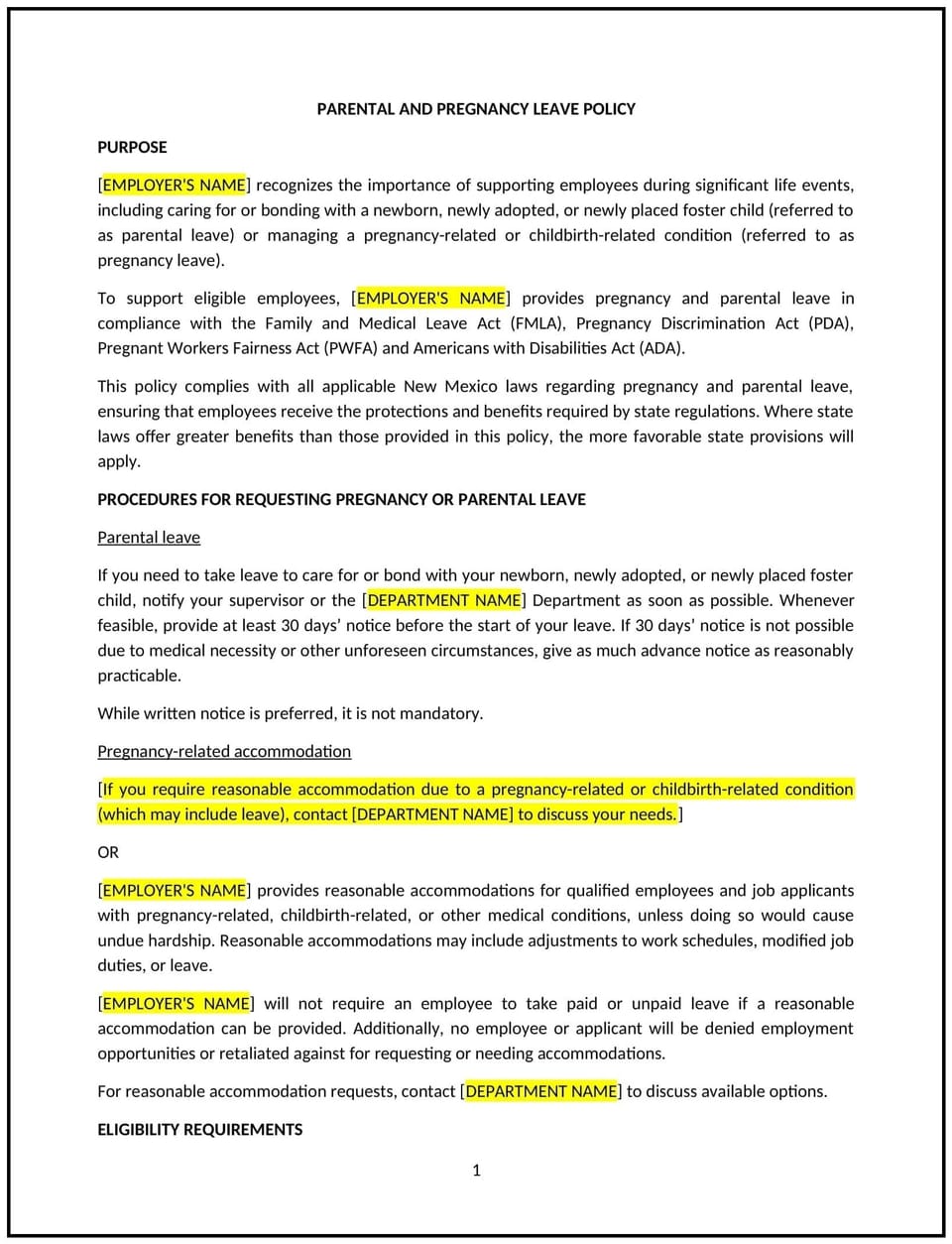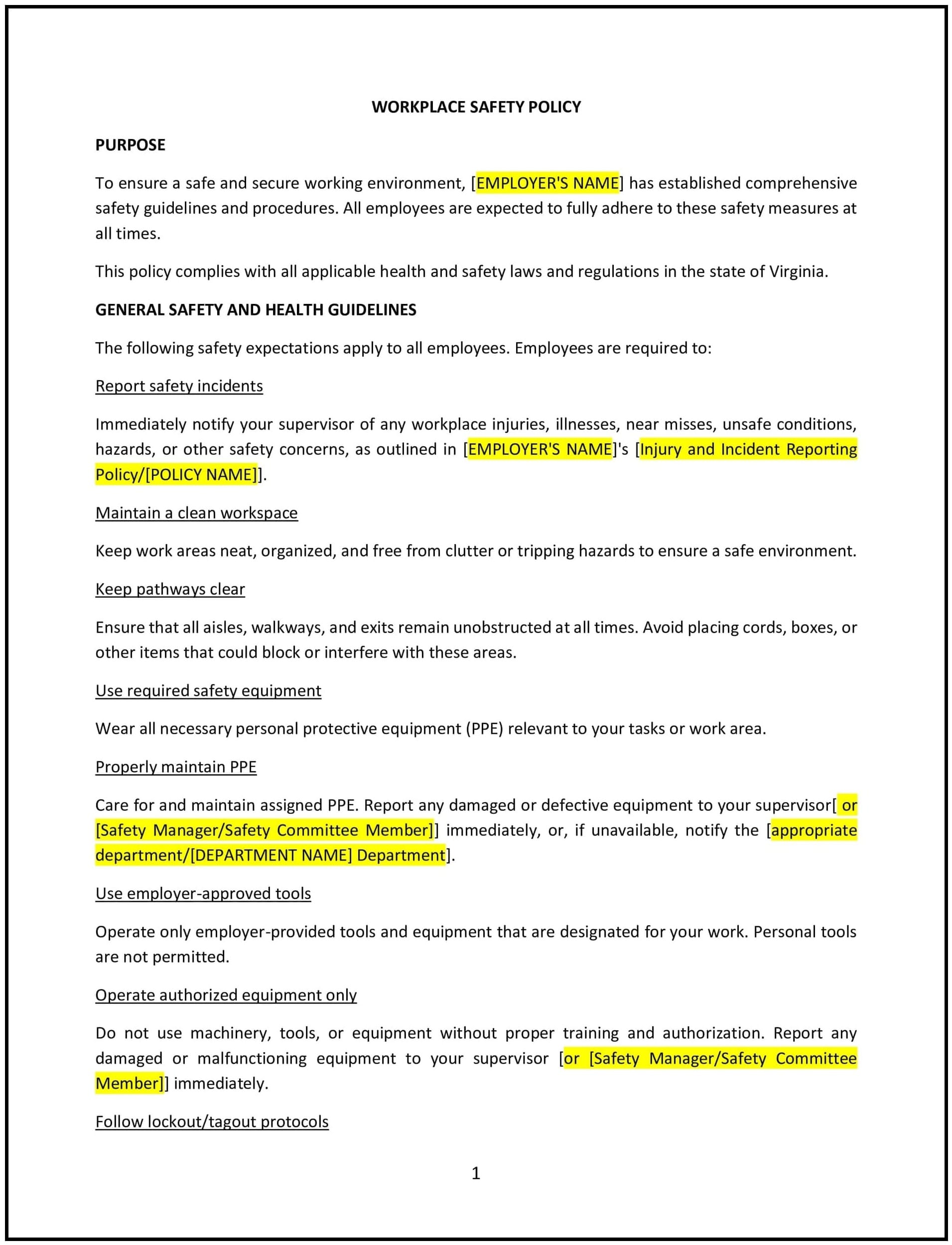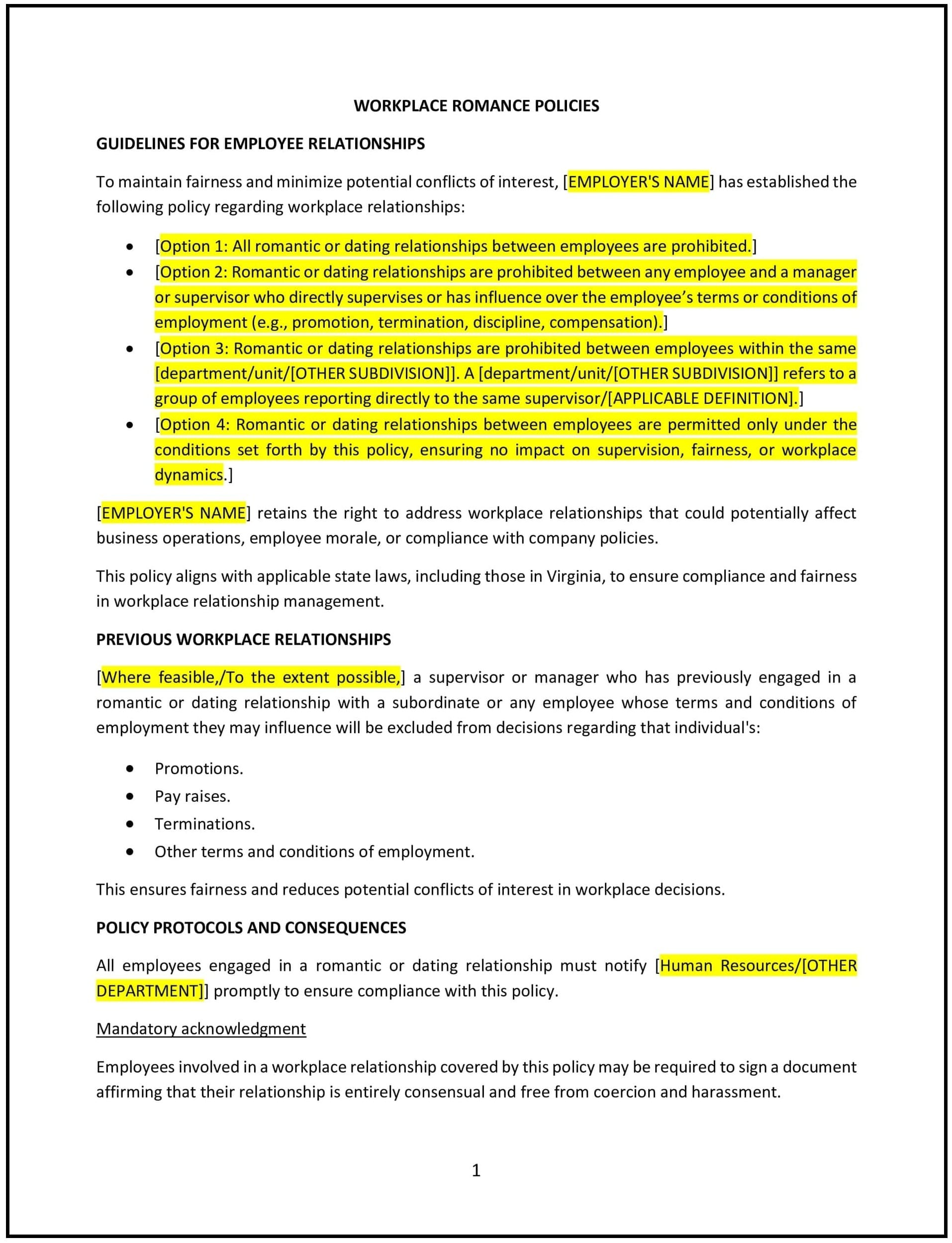Parental and pregnancy leave policy (New Mexico): Free template

Parental and pregnancy leave policy (New Mexico)
This parental and pregnancy leave policy is designed to support New Mexico businesses in providing paid or unpaid leave to employees who are pregnant or who are welcoming a new child into their family. The policy outlines the company's approach to supporting employees during pregnancy, childbirth, and the transition to parenthood, ensuring that employees are able to take the time they need without compromising their financial security or job.
By adopting this policy, New Mexico businesses can create a more inclusive and supportive workplace that prioritizes employee well-being, fosters gender equality, and reduces turnover.
How to use this parental and pregnancy leave policy (New Mexico)
- Define eligibility: Clearly specify which employees are eligible for parental and pregnancy leave. This may include full-time employees who meet a certain tenure requirement or other criteria.
- Outline leave duration: Specify the duration of leave that employees are entitled to, including whether the leave is paid, unpaid, or partially paid. For example, the policy could grant up to 12 weeks of leave for the birth or adoption of a child.
- Address pregnancy leave: Ensure that employees who are pregnant are provided with the necessary leave to recover from childbirth, as well as flexibility for prenatal appointments.
- Clarify the process for requesting leave: Set out clear procedures for requesting leave, including how far in advance the leave should be requested and the documentation (such as a doctor’s note or adoption papers) required for approval.
- Reflect New Mexico-specific considerations: Include any relevant New Mexico state laws or additional benefits regarding parental and pregnancy leave, including any paid family leave options or state-specific paid sick leave policies.
Benefits of using this parental and pregnancy leave policy (New Mexico)
Implementing this policy provides New Mexico businesses with several advantages:
- Promotes work-life balance: By providing employees with the necessary leave for pregnancy, childbirth, and new parenthood, businesses can help employees achieve a better work-life balance, which can improve job satisfaction and retention.
- Reduces turnover: Offering a comprehensive parental and pregnancy leave policy can help businesses retain talented employees by supporting them during important life events.
- Strengthens company reputation: A business that offers parental leave demonstrates that it cares about employee well-being and supports family life, which enhances its reputation as an employer of choice.
- Ensures equal treatment: The policy fosters gender equality by ensuring that all employees, regardless of gender, are entitled to leave when starting or expanding a family.
- Supports employee health: By offering time off for recovery from pregnancy or childbirth, businesses ensure the health and well-being of both the employee and the child, which can lead to fewer health-related absences in the long term.
Tips for using this parental and pregnancy leave policy (New Mexico)
- Communicate the policy clearly: Ensure that employees are informed about their rights and responsibilities regarding parental and pregnancy leave. Include the policy in the employee handbook and make it easily accessible to all staff members.
- Train managers: Train managers to handle leave requests with sensitivity and understanding, and to ensure that all employees are aware of the available leave options.
- Ensure consistency: Apply the policy fairly and consistently across all employees. Make sure that similar benefits are available to all eligible employees, regardless of their role or gender.
- Address leave transition: Create a smooth process for employees returning from parental leave, including offering flexible work arrangements or phased returns if necessary.
- Review the policy regularly: Periodically review the parental and pregnancy leave policy to ensure that it aligns with any changes to New Mexico laws, company needs, and employee expectations.
Q: Who is eligible for parental and pregnancy leave?
A: Businesses should define eligibility criteria based on employee tenure, status (full-time, part-time), and other factors such as whether the employee is a birth parent, adoptive parent, or has a pregnancy-related health condition. Typically, full-time employees who have been employed for a set period (e.g., 12 months) are eligible.
Q: How much leave do employees get for parental and pregnancy leave?
A: The amount of leave varies depending on company policy and applicable laws. Businesses should specify whether the leave is paid, unpaid, or partially paid, and provide the duration of leave (e.g., 12 weeks of unpaid leave for new parents under federal law or paid leave options under state law).
Q: Do employees need to provide documentation to take leave?
A: Yes, businesses should require employees to provide documentation such as a doctor’s note, a birth certificate, or adoption papers to verify the need for parental or pregnancy leave. This ensures that both the employee and business are clear on the expectations.
Q: Is parental and pregnancy leave available to all employees regardless of gender?
A: Yes, businesses should ensure that all employees—regardless of gender—have access to parental leave, including time off for the birth or adoption of a child, as well as recovery from pregnancy and childbirth. Gender-neutral language should be used to ensure equal access for all employees.
Q: Can employees take leave before the baby is born?
A: Yes, the policy should allow for leave before the birth of the child, especially if the employee is pregnant and needs time for recovery, prenatal care, or medical appointments. The policy should specify how much leave can be taken and whether it can be used in combination with other benefits, such as sick leave.
Q: Can employees return to work on a part-time or flexible schedule after parental leave?
A: The policy should allow for flexible work arrangements if needed. Businesses should offer part-time or phased returns to employees returning from parental leave, as this can help employees ease back into their roles while balancing family responsibilities.
Q: Can employees take additional leave after the standard parental leave period?
A: Businesses should specify whether employees are allowed to take additional unpaid leave if needed after the standard leave period has ended. If additional leave is granted, it should be addressed clearly in the policy, including any requirements for approval or documentation.
Q: How should businesses handle the transition back to work after parental leave?
A: Businesses should have a clear plan in place for helping employees transition back to work after parental leave. This could include offering flexible hours, providing access to support or counseling, and communicating expectations regarding work performance.
Q: How does the New Mexico state law affect parental leave?
A: New Mexico has specific laws regarding paid sick leave, which may apply to some employees taking parental leave. Businesses should familiarize themselves with state-specific regulations to ensure that employees’ rights are upheld, including any paid leave benefits available under state law.
Q: How often should the parental and pregnancy leave policy be reviewed?
A: The policy should be reviewed at least annually to ensure it remains aligned with changes in New Mexico state laws, federal regulations, and the evolving needs of employees. Regular reviews help ensure the policy is up-to-date and effective.
This article contains general legal information and does not contain legal advice. Cobrief is not a law firm or a substitute for an attorney or law firm. The law is complex and changes often. For legal advice, please ask a lawyer.


